5 Training Commands to Save Your Dog’s Life
Free Pet Insurance Comparison
Compare Quotes From Top Companies and Save
Secured with SHA-256 Encryption
Dr. Pippa Elliott BVMS, MRCVS
Veterinarian
Dr Pippa Elliott BVMS, MRCVS is a veterinarian with over 30 years of experience in companion animal practice. In 1987 she graduated from the University of Glasgow, with a degree in veterinary medicine and surgery. She works at Blythwood Vets and the People’s Dispensary for Sick Animals (PDSA). Pippa is an advocate of Fear-Free Practice, an animal addict, and a veterinary writer. She is also w...
Veterinarian
UPDATED: Dec 18, 2023
Pet Insurance U receives compensation from the third parties included on this site. This includes payment for clicks from our site to insurance providers’ sites and quote requests generated. Our rankings and reviews are not affected by payments from the insurance companies. The compensation we receive allows the site to be free and regularly updated. Our goal is to review every pet insurance provider, but not all companies are listed on the site.
And many of the companies we review do not pay us anything. We simply rate, compare and review their plan because we feel it will be valuable to you. Our reviews are guaranteed to be unbiased, professional and advertising compensation does not influence rankings.
We are a free online resource for anyone interested in learning more about pet insurance. Our goal is to be an objective, third-party resource for everything pet insurance related. We update our site regularly, and all content is reviewed by pet insurance experts.
UPDATED: Dec 18, 2023
Pet Insurance U receives compensation from the third parties included on this site. This includes payment for clicks from our site to insurance providers’ sites and quote requests generated. Our rankings and reviews are not affected by payments from the insurance companies. The compensation we receive allows the site to be free and regularly updated. Our goal is to review every pet insurance provider, but not all companies are listed on the site.
And many of the companies we review do not pay us anything. We simply rate, compare and review their plan because we feel it will be valuable to you. Our reviews are guaranteed to be unbiased, professional and advertising compensation does not influence rankings.
On This Page
Imagine how you would feel if your dog ran into a busy street, ignoring your calls because he or she didn’t understand what you were trying to communicate?
Obedience training needs to be about safety, rather than tricks. Here are 5 must-know obedience commands that you should start practicing now.
These 5 Commands Could Save Your Dog’s Life!
- Sit: From stopping dogs at the curbside to keeping them from jumping up, “sit” puts you in control.
- Stay: Keeps the dog in one spot so that you can catch up and put the leash on.
- Recall: Stops the dog from running off or approaching unfriendly canines (or people).
- Leave it: Prevents dogs from eating something they shouldn’t.
- Look: Focuses the attention so dogs don’t see dangerous distractions.
Need Pet Insurance?
FACT: Pet insurance pays up to 90% of vet bills when your pet is sick or injured!
Enter your ZIP code below to view companies that have cheap pet insurance rates.
Secured with SHA-256 Encryption
The Lies Dog Trainers Tell
Lie: The whole “pack theory” idea is a myth and it doesn’t work for training dogs.
Fact: Positive reinforcement or reward-based learning with treats and praise is the best way to train your dog. This scientifically validated approach follows the laws of operant conditioning, which state that actions that are rewarded are likely to be repeated.
For example:
- Giving praise and/or a small treat for sitting makes a dog eager to repeat the action to earn the reward.
- Shouting at dogs when they bark actually rewards them with attention, making them more rather than less likely to bark in the future.
#1: How to Teach a Dog to “Sit”
[wpsm_video schema=”yes” title =”How to Train Your Dog to Sit” description =”Teach your dog or puppy to sit in under 3 minutes.”]https://youtu.be/WtD2GRbbyzU[/wpsm_video]
Tiny but tasty treats are the perfect thing to hold dogs’ attention and reward them. Start out teaching your dog the steps listed below in a quiet room with few distractions.
Once the behavior has been reinforced, try rewarding sitting in a variety of locations so that the command will be followed regardless of the circumstances.
Here’s all you need to do:
- Hold a treat between your finger and thumb, just in front of the dog’s nose.
- Let your dog sniff the treat (but not eat it).
- Raise the treat and move it slowly so that the dog’s nose follows it
- When dogs track something this way, they naturally sit down.
- As soon as the dog is in a sitting position, say “sit”, in a pleasant but firm voice.
- Give the dog the treat along with lots of praise.
- Repeat these steps several times during each training session and whenever opportunities arise during the day, such as before feeding or putting on a leash.
Related: 10 Things You Must Know Before You Buy Pet Insurance
When To Use “Sit”
“Sit” is a great way to put you back in control. Here are some situations where this command comes in handy:
- Curbside: Training dogs to sit at the curb helps keep them from dashing out into the road.
- Greeting: Train your dog to greet visitors by sitting rather than jumping up.
- Prevent Chasing: Teaching dogs to sit in any situation means that you can stop them from chasing other pets or children.
- Door Barging: Training dogs to sit before leaving the house will help prevent them from running out the door.
- Calming: Sitting gives an over-excited dog a chance to calm down.
What If Your Dog Won’t Sit?
When a dog fails to follow this command:
- Distractions: Try reinforcing the behavior in a different room or area without a TV or other people or pets present.
- Treats: Make sure that the reward is a really tasty treat that the dog loves and will work for.
- Technique: Make sure that your hand isn’t too far away from the dog or moving too fast, and that the reward comes immediately after the behavior and is accompanied by praise.
What if Your Dog Sits At Home But Not Outside?
Failure to follow the command in unfamiliar situations could be due to:
- Incorrect Associations: A dog can come to associate obedience with only one particular location. For example, a dog that is always trained in the kitchen may link sitting to the presence of the refrigerator. The answer is to practice sitting in lots of different locations.
- Distractions: Young dogs, in particular, have short attention spans and are easily distracted. Keep practicing away from home but be sure to keep your voice gentle and friendly. It may help to use special, extra-tasty treats when you are in unfamiliar places.
Real Cost Savings from PetFirst Clients

Luna
PetFirst saved his parents
$6,712
A happy energetic Luna one morning couldn’t hold her food down. After months of multiple costly vet visits to specialists and an endoscopy, the problem was discovered and fixed. Luna put 22 pounds back on in no time and her parents were grateful for having PetFirst by their side to pay the bills.
What If Your Dog Isn’t Motivated By Food?
A chowhound is usually easier to incentivize, but with some canine cunning, you can find the right motivator.
- Try different treats: Almost every dog has a weakness for something; you just have to work to discover what it is. Hint: very few dogs can pass up a slice of liver.
- Try different rewards: If food really doesn’t do it, then use something else the dog likes, such as a game of fetch or even just a whole lot of “who’s a good dog?”
#2 How to Teach a Dog to “Stay”
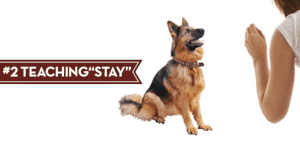
Teach this command after sitting, working first on the amount of time the dog stays, and then on the distance (rather than both time and distance at once). [1]
- Start with the dog in the sitting position at your side.
- While the dog is sitting, take one step away.
- Hold your palm out toward the dog and say “stay.”
- Wait a second or two, then step back toward the dog and deliver the reward.
- Gradually increase the interval between the command and the reward.
- Once the dog learns to sit still for ten seconds or so, take another step away before giving the command.
- Gradually build up the “staying” distance between you and the dog.
When To Use “Stay”
Staying is important for convenience and safety in such situations as:
- Attaching a leash: This command gives you time to keep your dog in place until and while you put a leash on.
- Avoiding danger: Staying in one spot helps keep a dog from unsafe situations such as running in front of cars and getting into fights with other dogs.
- Control: A dog that knows how to stay can be prevented from such undesirable behaviors as grabbing food or jumping up on people.
What If Your Dog Won’t Stay?
Failure to follow this command means a failure in training, so review the steps outlined above:
- Back to Basics: Make sure that the sitting command has been thoroughly taught, and then slowly build up the amount of time that the dog stays. It might be that you are expecting too much too soon from your pooch.
- Build Concentration: Remember to work first on getting the dog to stay for a few seconds before working on distance.
- Hide Frustration: Never let your dog see that you are unhappy with the progress you are making; this just makes for more anxiety and encourages the dog to run over to you.
Enter your ZIP code below to view companies that have cheap pet insurance rates.
Secured with SHA-256 Encryption
#3: How to Teach a Dog Recall Training
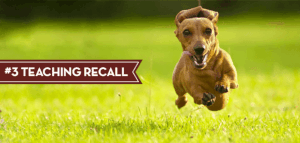
When a dog returns to your side on command, you have taught perfect recall. This is a crucial part of safety, and it allows you to exercise a dog without a leash.
- Puppies have a strong instinct to follow their owners, so reward this natural behavior.
- Add the cue word “come” as the dog runs to you and deliver the reward together with lots of praise and/or a treat, thus associating the behavior with the reward.
- When training older animals, use a toy to attract the dog’s attention from only a short distance away and then shout “come” in an excited voice. When the dog reaches you, give a reward and the toy.
- Repeat these steps often and at every opportunity. For example, say “come” at the dog’s feeding time so that dinner becomes a reward.
When To Use Recall
- When a dog is off the leash and you spot a potential danger.
- To prevent a dog from running off.
- To get a dog back in the house or the car after play.
What If Your Dog Ignores My Recall?
- Persistence Pays: Don’t give up. Some dogs are slow learners, especially with recall.
- Ultra-Tasty Treats: Use your dog’s most favorite treat so that the word “come” is strongly linked to an irresistible treat.
- Remove Distractions: Start training in a place with as few distractions as possible to reinforce the habit of responding before moving to more challenging environments.
- Never Punish: Never, ever, scold your dog, no matter how long it takes finally to return. Punishment makes being reunited an unpleasant experience that a dog will therefore seek to avoid. No matter how frustrated you become, welcome your dog with open arms and lots of praise so that there are only positive associations with recall.
- Never Nag: Avoid “nagging” your dog with repeated shouts to come. If you use a command too often, the dog will simply tune it out. Instead, keep the dog on a long leash during training until you are more confident with the recall command.
#4: How to Teach a Dog to “Leave It”
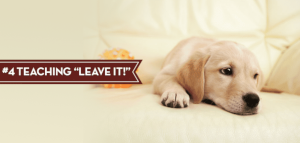
What would you do if your dog was about to bite into some rat poison? This is the kind of situation in which you need to be able to command your dog to “leave it!”
Learning this command takes some time since it must be done in stages, but it’s obviously worth the effort, since it could save your dog’s life.
Training Your Dog to “Leave It” in 5 Easy Steps
Step 1: Interrupt your dog’s focus on a treat
- Have the dog sit. You will need a treat that is interesting, but nothing too tasty.
- Show this so-so treat in your hand, then close your fingers around it.
- Allow the dog to sniff your closed hand. The moment he looks away, say “leave it” and open your hand to deliver the reward.
- Once the dog associates looking away with receiving the treat, move on to Step 2.
Step 2: Have your dog look to your other hand for the reward
- For this step, you will need two treats, one of the so-so kind and one that is especially tasty.
- Hide the exciting treat in one hand behind your back, then show the dog the boring treat with your other hand and proceed as in Step 1.
- This time, when the dog looks away and you say “leave it,” deliver the hidden super tasty treat as the reward. The message here is that leaving one object of interest leads to a far more tasty reward.
- Once the dog reliably leaves the so-so treat alone and waits for a reward, move on to Step 3.
Step 3: Have your dog ignore a treat on the floor
- Instead of holding the so-so treat in your hand, place it on the floor, but keep a finger on it to keep the dog from grabbing it.
- Say “leave it,” and when the dog looks up from the so-so treat, deliver the tasty treat as a reward.
- Build up the dog’s willingness to leave things alone by moving the so-so treat slightly further from your hand and removing your finger. Be sure to give lots of praise when the dog does “leave it!” and looks for a reward instead.
When Should You Use “Leave It”?
From that dead bird in the park to your tennis shoe to a diamond engagement ring, the “leave it” command is for anything that you don’t want your dog to chew up or swallow.
What If Your Dog Won’t “Leave It”?
- Some dogs stumble at the first hurdle. If your dog is completely focused on the so-so treat in your hand and keeps trying to grab it, try using an even less tasty treat, such as a piece of regular kibble. Attract the dog’s attention, but not to the point of obsession.
- Other dogs stumble at the second step. If your dog won’t shift attention from the first hand, then make the second treat even tastier (consider cheese or sausage or some other delicacy reserved for special occasions) and make sure that the dog sees and sniffs it, and then take away the first treat.
- Sometimes leaving things on the floor is a step too far. Try covering the treat on the floor with a cupped hand, and once the dog learns to keep away from your hand, then try holding the treat on the floor with just a finger.
- Some dogs figure out that there is a difference between training and real life, and won’t leave things away from home on walks. The key here is to beef up the training by doing the steps in different locations. It can also help to use different items as your so-so treat, thereby reinforcing the idea that “leave it” leads to a sure-fire reward, while the so-so reward is not worth the effort.
#5: How to Teach Your Dog Eye Contact with “Look”
“Look” is a command for getting your dog’s attention focused on you, rather than on some distraction off in the distance. To teach this command, follow these steps:
- Hold out a tasty treat near the end of your sitting dog’s nose.
- As your dog watches the treat, slowly move it up toward your forehead and eyes.
- While your dog’s attention is focused on the hand holding the treat, say “look.”
- Count to ten, then give the treat to the dog.
- With practice, the dog’s attention will automatically move to your forehead and eyes when you say “look.”

When To Use “Look”
- This command is for situations where you spot a potential problem, such as something your dog fears or is aggressive toward.
- Use “look” to distract a dog from something that might set off barking.
- Getting your dog to “look” can give an unfortunate cat a chance to slink off without being chased.
What If Your Dog Won’t “Look”?
- Make sure that your dog is rock solid at sitting and is able to resist the urge to jump at the treat before moving it toward your head.
- For dogs that lack concentration, use a super tasty treat.
- If your dog looks away too soon, start with just one second before delivering the reward and build up the time from there.
Dog training is an ongoing effort but sticking with it will improve your relationship with your pooch and make your time together more enjoyable.
Enter your ZIP code below to view companies that have cheap pet insurance rates.
Secured with SHA-256 Encryption
Most Important Tips During Your Dog Training
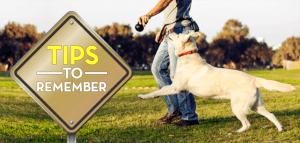
Always remember to:
- keep training fun for both you and your dog
- make your training sessions brief and frequent, for instance, five minutes four times a day (this is much more effective than fewer, longer sessions)
- end each training session on a positive note with a command that your dog already knows
- train every day
- be liberal with praise
- never punish mistakes; just let them go and try again with something less tricky
Other articles you may find helpful:
Is Exotic Pet Insurance Necessary?
The Best Pet Insurance By State
Fun Facts, Dog FAQ, And Unsolicited Dog Advice
5 Training Commands to Save Your Dog’s Life
The Ultimate Guide to Safe Foods for Dogs
We hope you enjoyed this article about dog training techniques. You should consider looking into pet insurance for your pet and you can start by checking out the best rates for dog and puppy insurance.
Let’s Talk Muzzles: The Hows and Whys of Muzzling Dogs
Choke, Prong and Shock Collars: Effective Tool or Unnecessary Risk?
Dog Body Language – What’s Your Dog Telling You?
Five Fun Ideas for Ball-Crazy Dogs
He’s Not Spoiled, He’s My Dog: In Defense of ‘Crazy’ Pet Owners
Rewarding Your Dog: Why and How it Works
How to Stop Dog Barking At Night
Tips To Help Stop Your Dog From Sitting Down On Walks
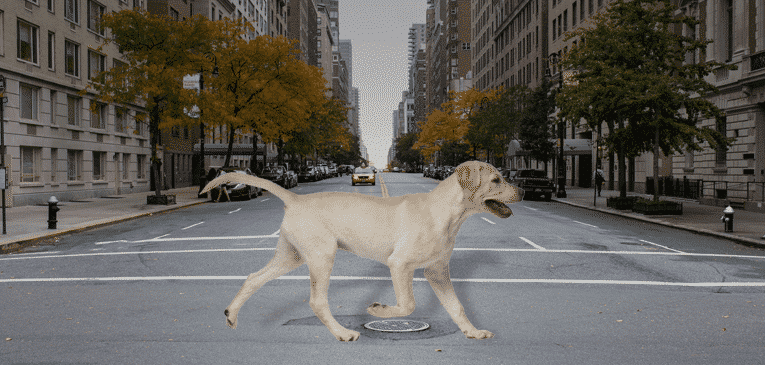
Frequently Asked Questions
Why is “Sit” a crucial command for dog training?
“Sit” is a fundamental command that helps put the owner back in control and proves handy in various situations. It is an essential safety command.
How can I train my dog to “Sit”?
Use tiny but tasty treats to get your dog’s attention and reward them when they follow the steps to sit. Practice in a quiet room initially and gradually introduce distractions
When should I use the “Stay” command for my dog?
“Stay” is important for convenience and safety in situations such as when you need your dog to remain in one place, avoiding potential dangers.
How can I teach my dog recall training?
Recall training involves teaching your dog to return to your side on command. This is crucial for safety and allows you to exercise your dog without a leash.
Why is the “Leave It” command important?
The “Leave It” command is vital for preventing your dog from interacting with or consuming harmful items. It could potentially save your dog’s life.
What is the purpose of the “Look” command?
The “Look” command is used to get your dog’s attention focused on you rather than distractions. It helps in maintaining control in various situations.
How do I train my dog to make eye contact with the “Look” command?
Follow the steps outlined in the article, gradually getting your dog to focus on you rather than distractions.
Why is patience crucial during dog training?
Training takes time, and being patient is essential for the dog to understand and respond to commands. Lack of patience can hinder the training process.
Is pet insurance necessary for my dog?
Yes, pet insurance is recommended as it can cover up to 90% of vet bills in case your pet is sick or injured. It provides financial protection for unexpected medical expenses.
What are the 5 training commands mentioned in the article to save a dog’s life?
The five essential training commands that can potentially save a dog’s life, as commonly mentioned in articles, are:
- Recall (Come): Teaching your dog to come when called is crucial for their safety, especially in situations where they might be in danger or about to wander into a risky situation.
- Sit: A fundamental command that can help control your dog in various situations, keeping them in place and preventing them from engaging in potentially hazardous behavior.
- Stay: Teaching your dog to stay in a particular spot or position can prevent them from running into danger or approaching potentially harmful objects or situations.
- Leave It: This command helps to prevent your dog from picking up or interacting with dangerous objects, substances, or even other animals that could pose a threat.
- Heel (Walking nicely on a leash): Ensuring your dog walks calmly beside you without pulling on the leash can be crucial for their safety, preventing them from darting into dangerous areas or traffic.
Regular training and reinforcement of these commands can significantly contribute to your dog’s safety in various situations.
Enter your ZIP code below to view companies that have cheap pet insurance rates.
Secured with SHA-256 Encryption
Dr. Pippa Elliott BVMS, MRCVS
Veterinarian
Dr Pippa Elliott BVMS, MRCVS is a veterinarian with over 30 years of experience in companion animal practice. In 1987 she graduated from the University of Glasgow, with a degree in veterinary medicine and surgery. She works at Blythwood Vets and the People’s Dispensary for Sick Animals (PDSA). Pippa is an advocate of Fear-Free Practice, an animal addict, and a veterinary writer. She is also w...
Veterinarian
We are a free online resource for anyone interested in learning more about pet insurance. Our goal is to be an objective, third-party resource for everything pet insurance related. We update our site regularly, and all content is reviewed by pet insurance experts.


